There is so much debate in the golfing community as to what the correct stance width is. Many of the best golf swings of the past featured a narrow stance but modern teaching seems to have moved towards a wider stance. But which one is the correct one?!
From looking at the top players, it’s clear that so many different stance widths can be used effectively. The best stance width will depend on the characterists of each golfer’s body and swing.
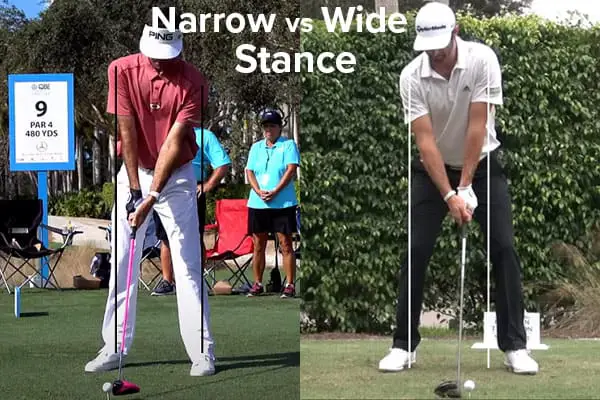
There are advantages and disadvantages to each and experimentation is important. It’s easy to take a wide stance because you think that’s the right way to do it or through force of habit but in fact, a narrow stance may be more beneficial to you. And vice versa.
In this article I’m going to go through the adantages and disadvantages of each and look at some examples of the best players in the world.
The benefits of a wide stance are generally related to improved balance and more centred rotation.
Wide golf stance benefits include:
A wide stance can reduce swaying, or lateral movement, by keeping the golfer more centred. This can help to achieve better rotation during the golf swing.
Too much lateral movement during the swing tends to make proper rotation and hip motion very difficult. A wider stance can help prevent this large weight shift by making it more difficult to move your center of mass.
Not only can a lot of lateral movement cause problems with rotation but it can also make ball striking very difficult. If you make a large move off the ball in the backswing, then you have to make a large move back to the ball during the downswing. However, the move is much more difficult during the downswing since it happens so much quicker than the backswing.
Usually, excessive lateral movement leads to a loss of balance. This results in inconsistencies at impact and ultimately, poor ball striking. Watching the best players in the world, it is clear that balance is incredibly important.
A wide stance can benefit golfers who have problems with balance and particularly those with a large amount of lateral movement during the swing. If you are someone that struggles with balance, be sure to check the width of your stance and feel free to experiment with a wider stance.
However, a wider stance is not necessarily a quick fix. Poor balance could be the sign of some underlying swing flaws. Whilst a wider stance may provide some relief, it is unlikely to solve the root of the problem.
With many of the top players in the world adopting a wide stance, it’s easy to see why so many average golfers think it’s the way to go. However, it should be noted that a golf stance can be too wide. Whilst it may help you with some aspects of the swing, it may hinder you in others.
If you have a large problem with lateral movement, for example, a wide stance may help but it will probably be better in the long run to address the problem directly. A wider stance will probably only be the best solution to this problem if you already have a very narrow stance.
The main benefits to a narrow stance are:
Whilst a wide stance can help to keep you centred and improve balance, it can make it much more difficult to turn.
This is where a narrow stance can offer many benefits. It’s easy to look at the pros on tour and copy their wide stances. However, most of them are extremely flexible and are able to turn very well with a wide stance.
But the aveage golfer tends to be much less athletic with a much lower level of flexibility. Even many physically fit amateur golfers struggle with flexibility, whether they like to admit it or not. The golf swing is a complex move that demands a lot from the body in terms of flexibility.
I think it’s important to be honest with yourself and your own limitations. If you tend to struggle with rotation at all, there is a good chance you would benefit from a narrow golf stance.
It is true that staying balanced and centred can be a little more difficult with a narrow stance. But for the average golfer I think the ability to turn easier largely outweighs any negatives.
Additionally, shifting your weight to you front foot should be easier with a narrow stance. Many players that adopt a wide stance struggle to get onto their frint foot during the downswing, producing high weak shots and inconsistent strikes.
If you experiment with a narrower golf stance, just be sure to focus on your balance as you swing. Try not to let your weight move too much to the back foot in the backswing. A little weight shift is good but don’t overdo it.
If you lack a little flexibility and you tend to use a wide stance, you should find that the golf swing becomes much easier with a narrower stance.
Dustin Johnson and Rory Mcilroy are two world class PGA golfers that spring to mind when I think about a wide stance.
They are both know for their perfect balance along with their extraordinary power. However, I don’t think it’s any coincidence that they are two of the most flexibile PGA pros on tour.
Take a look at the video of Dustin Johnson below and pay attention to his stance width but also the flexibility that he utilises throughout the swing.
You can see that his stance is much wider than shoulder width, with his heels outside his shoulders. This allows him to stay very centred throughout the swing, eliminating any sway, or lateral movement.
The camera in angle is slightly off to one side which makes the ball position look like it is back a little. But from the image below you can see how much wider than his shoulders his feet are. It’s a very powerful looking stance!
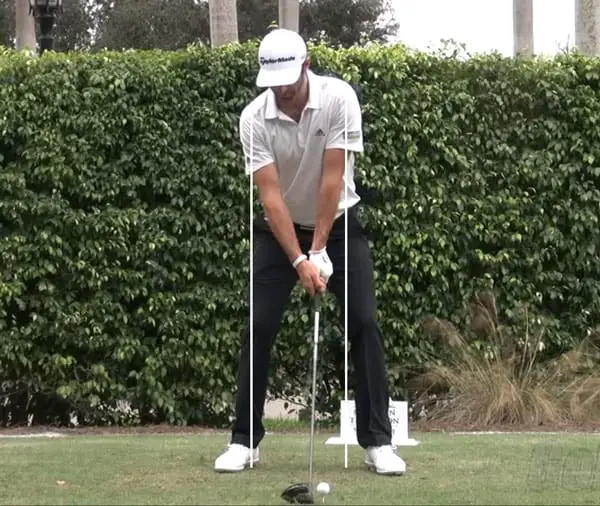
But many golfers would struggle with this wide stance. Unless they are very flexible and already have excellent hip rotation. This wide stance is probably best suited to young and flexible golfers.
Take a look at the image of DJ’s top of backswong below. The amount of flexibility this guy has is incredible!

If you decide to try a wider stance, just be careful to ensure that it doesn’t limit your hip turn. You should be able to turn freely both on the backswing and the downswing. Make sure that you don’t get stuck on your back foot during the followthrough as well.
Bubba Watson is one of the most well known PGA golfers with a narrow stance. He uses the narrow stance to great effect, making a huge, free turn.
Takie a look at the video of Bubba below and notice his narrow stance and how much of a turn he makes in the backswing. With his irons he often uses a very narrow stance. Even with his driver he rarely goes wider than shoulder width.
From the image below, we can see Bubba’s narrow stance clearly. Even with the driver, his stance is only just shoulder width wide.
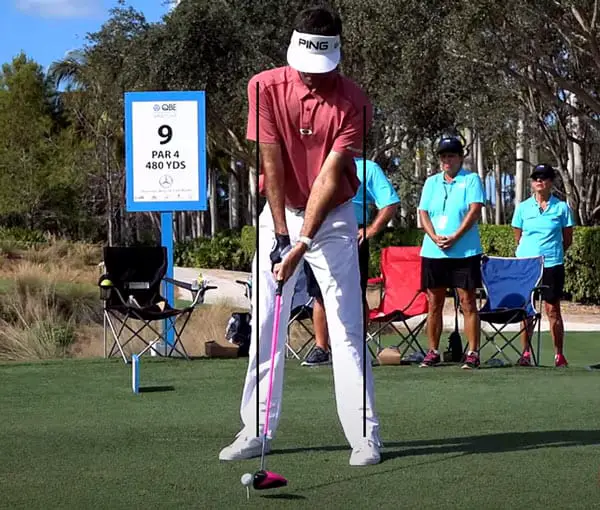
Looking at Bubba’s top of backswing position below, we can see how he uses his narrow stance to his advantage. He allows his front knee to move inwards to enable as much hip rotation, and therefore shoulder rotation, as possible.

He is able to get his hands in a similar high position to Dustin Johnson, wihtout requiring as much flexibility.
With an iron, Bubba uses one of the narrowest stances of any PGA player. But he is still able to generate plenty of power. Look at the image below where his stance is less than shoulder width wide, even with a mid iron.
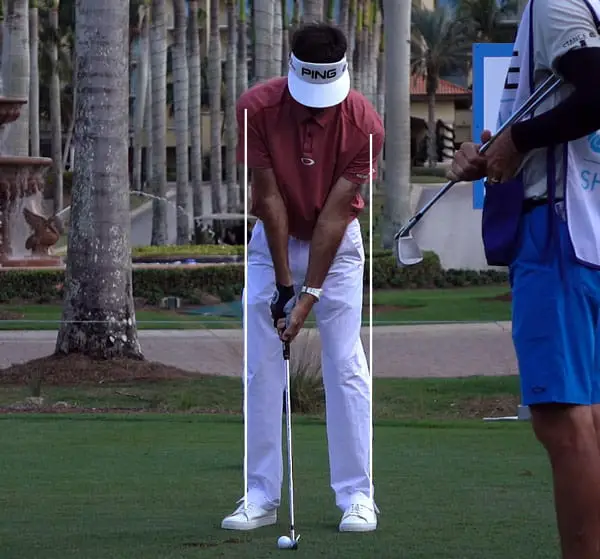
This narrowe stance would probably be well suited to a lot of club golfers, especially if they usually adopt a wide stance. By narrowing your stance, you may find that you are able to use your lower body much more effectively.
It is not very common for golfers to take a narrow stance with the driver. In fact, if you asked most golfers whether you could use a narrow stance with the driver, they would probably tell you it wouldn’t work. On the face of it, a narrow stance with the driver doesn’t seem to make sense.
The driver is a longer club, we are taking a longer swing, and balance is more important so you would think a narrow stance would be counterintuitive. Also, we want to hit more up on the ball with the driver so it seems to makes sense to move the back foot further away from the ball. Not to mention that a wide stance feels more athletic and powerful.
For a long time this was the way I thought, and I adopted a very wide stance with the driver. However, I have since adopted a fairly narrow stance with the driver and I have found it to help my driving immensely.
Since I switched to a narrower stance, it has helped me to rotate better in both the backswing and downswing. This has allowed me to make a much freer, wider, and longer swing with less tension. As a result, I have been able to generate more speed.
In addition, I have been able to improve my ball striking and ball flight.
Like many amateur golfers, I often struggled with the drive that went too high with too much spin. Often, it would feel like I hit a good drive and the ball would set off well only to balloon up into the air and fall down with snow on it.
Most golfers are quick to look to the loft on their driver, thinking that less loft will help. Whilst less loft may help somewhat, it likely won’t fix the root cause of the problem.
Unless you are a golfer that generates a tremendous amount of speed (115mph+), too much loft on the driver is probably not the issue. The real problem is probably that you are adding loft to the club at impact. This is usually referred to as a flip, or more specifically an underflip (as opposed to a roll, which usually causes a hook).
An underflip at impact can be pictured by imagining a golfer trying to scoop the ball in the air. Many beginners do this as they think they have to help the ball in the air. But of course this isn’t necessary since the club has the correct loft to lift the ball.
But even good golfers can perform an underflip, which is usually caused by poor body rotation through impact, or a stall as it is often known.
A stall is basically the name we give to the motion where the body stops turning at impact or just before impact.
When the body stalls, the hands and wrists take over, typically leading to an underflip which adds loft to the club.
This increase in loft results in the high shot with too much spin. With an iron, this can often produce a decent golf shot. But with a driver, where we are producing more speed, the effect is usually exaggerated, resulting in a severe loss in distance.
A narrower stance can help to improve body rotation through impact, especially in the hips and pelvis. This improved rotation can help to reduce the amount of underflip, or even remove it alltogether.
The result is a golf club that is delivered to impact with the correct amount of loft, as opposed to too much loft. This helps to produce a more penetrating flight with less spin.
You should find that the ball is less affected by wind, travels further through the air, and runs out more on landing. It really is a win win win!
There is no definitive answer to how wide your golf stance should be with a driver. As with most things in golf, the correct stance will depend on your swing tendencies and body flexibility/limitations.
Don’t be afraid to experiment with stance width to find out what works for you. You may find a narrow stance helps you turn better. But you may find a wide stance helps your balance.
In my opinion, the majority of club golfers that I see use a driver stance that is far too wide for their level of flexibility.
As a starting point, trying a driver stance where your heels are directly underneath your shoulders or just inside them is probably a good starting point. It can be useful to practice this stance in front of a mirror. I find it useful to pay more attention to the width of the heels rather than the toes, since flared feet can cause an illusion.
For people that are used to a very wide stance, a narrow stance will probably feel like you’re hitting an iron! But that might be a good thing!
Hopefully, you will find that your rotation is improved, along with your ball flight and consistency. You will probably find that the ball lanches a little lower with a narrower stance so you may wish to move the ball further up in your stance if you need more height.
As well as producing a more penetrating flight, a narrower stance can help to reduce any hook or slice tendencies you may have with your driver.
On the flip side, if you are used to using a narrow stance, you may find a wide stance helps you. Just listen to your body and experiment. The most important thing is how well your body moves throughout the swing.
A narrow stance can help your ball striking throughout the bag. Typically it can make the biggest difference with the longer clubs, since this is where you normally take a wide stance.

Unless you are a very skilled golfer, you could probably improve your body rotation. All the best ball strikers have excellent rotation through impact. This prevents the clubhead from passing the hands and leads to consistent contact. As well as improving clubhead speed.
I switched to a narrower stance and found that it greatly improved my rotation. The biggest improvement probably came with my driver, where I was using a stance that way was too wide.
As well as my driving, I found that a narrow stance significantly helped my iron play. I found it much easier to get some forward shaft lean at impact – the key to excellent iron striking.
The improved rotation from a narrow stance can help your ball striking with every club. I found the sweetspot more often, the trajectory was more consistent, and the dispersion was tighter. I also picked up a little distance, but I think this was mainly due to the quality of strike.
Although a narrow stance tends to make swaying easier, it also makes it easier to detect. You may find that a narrow stance makes you much more aware of where your balance is and allows you to control it better.
An excellent drill I like to use for this is as follows:
I like to do this drill with a 7 iron but you could use a shorter club if you like. You could also tee the ball up on a short tee if you are struggling with contact (although I recommend hitting off the deck). If you are finding it difficult to rotate, you can widen your stance a fraction.
The purpose of the drill is not to limit your rotation, you still want to turn well. However, the drill will help you to keep centred during the swing.
With your feet together, you will be unable to sway or slide during the swing. As strange as it sounds, you may actually find the drill helps your rotation.
I also find this drill helps my ball striking. It helps me to get into a better position at impact where my hands are ahead of the ball. I have a tendency to slide ahead of the ball on my downswing and flip with my hands. But I can’t do that with my feet together.
Instead, I get more of a feeling of covering the ball with my upper body. This results in better rotation and balance, quieter hands, and produces a more solid contact with a more penetrating ball flight.
Once you have developed this feeling, you can move to a normal stance and hit 3/4 shots. Then you can move to hitting full shots while retaining the same feeling.
The golfers who are most likely to benefit form a narrow stance are senior golfers. As you become older and your flexibility reduces, achieving more rotation in the golf swing becomes much more important.

Young golfers can generally get away with having a stance that is too wide. Their rotation may be reduced but their flexibility in the hips and spine can often make up for this, allowing them to rotate OK.
Senior golfers need to be much more in tune with their bodies to get the most out of their game. Just because you have some more physical limitations, it does not mean that you cannot play great golf. You only have to look at the golfers on the senior tours to see what is possible.
Take a look at the video of Greg Norman hitting driver below and notice how narrow his stance is. It had definitely got narrower over the years. You can see he addresses the ball very wide but then narrows his stance before making the swing.
By taking a narrow golf stance, you should be able to achieve more freedom in the hips. This often leads to:
All of these benefits combined can result in increased distance as well as improved ball striking and consistency.
Take a look at the senior golfer below that is using a narrow stance. I love the way he’s allowed his front heel to lift a little to enable him to get an excellent full backwing. I like the soft left arm as well. Look how relaxed and tension free he looks.

As with any golfer who chooses to adopt a narrow stance, you still need to be aware of swaying (too much lateral movement) and loss of balance. Be sure to try to stay fairly centred and to retain your balance throughout the swing. A little weight shift towards the back foot is OK, even desirable, but don’t overdo it.
If you are a senior golfer with a fairly wide stance, I would highly recommend trying a narrower stance. You may be amazed at how much it improves your golf swing.
I think it is somewhat of a myth that a wider stance produces a shallower swing. Also, even the phrase “shallow swing” gets easily confused.
There is a difference between a shallow angle of attack and a shallow swing plane. A shallow angle of attack produces little to no divot, whereas a shallow swing plane produces a more rounded, flatter swing.
There is some correlation between the two since a more shallow swing plane can produce a more shallow angle of attack. However, the correlation is very complicated and cannot be simplified easily.
In an ideal world, you should aim for a swing that is shallow through impact, to help with consistency. But, you don’t necessarily want a shallow swing plane since that can lead to getting flat.
A flat backswing can lead to an over the top move which produces a pull/slice or a very inside out downswing which lead to pushes/hooks.
When we think about the swing in 3 dimensions, it is difficult to see how a wide stance on it’s own can lead to a shallower golf swing.
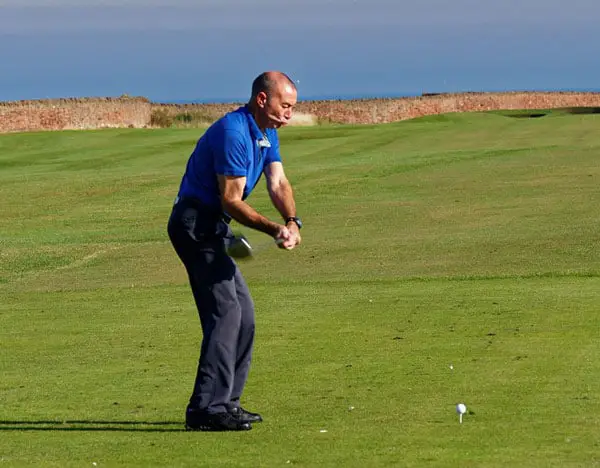
A wider stance may create the feeling of more width and shallowness at address, but a stance that is too wide will hinder rotation. A common result of this poor rotation is actually an angle of attack that is too steep. This usually results in large divots with irons, too much spin with the driver, and inconsistent ball striking.
In addition, a swing that is more shallow is not neccesarily a better swing. I think it is generally better to focus on achieving the best rotation you can. This may mean using a more narrow stance.
By working on proper roation throughout the swing, you will be able to achieve a more consistent impact that results in superior ball striking.
An extra wide golf stance is something that you don’t really see any pros use. Generally, it will limit rotation too much.
However, an extra wide stance can be very useful in windy conditions.
Being from the UK, I have played on many British links courses. At times if can be so windy that it is difficult just to stand still, let alone swing a club!
In these conditions, an extra wide stance is pretty much a necessity. I have personally experienced the most success with a very wide stance and a short swing.
The wider stance will likely hinder your rotation so it’s easier to keep your swing short (3/4 swings). A shorter swing will also lower your swing speed and help to keep the spin down. This is incredibly important in strong wind.
But under normal conditions, an extra wide stance is generally not advisable. Even if you are very flexible, it will likely make it too difficult to turn properly during the swing. Your power and consistency of strike will probably suffer massively as a result.
An extra wide putting stance is also excellent in very windy conditions. Since we don’t need much body rotation for putting, there are virtually no downsides to a wide putting stance.

For those that tend to move the body too much, an extra wide stance may actually improve your putting under normal conditions.
If you find that you tend to lose your balance a little while putting or you tend to move your body on the stroke, try a wide putting stance. You may find that it gives you more stability and repeatability.
For many golfers, a narrow putting stance can be beneficial under normal conditions.
Although it is typically a good idea to keep the lower body still, some movement can help. A narrow putting stance can help to free up the stroke, especially on longer putts. This is where a wide stance can hinder the putting stroke.

If you tend to feel a little tense while putting, try a narrow stance. It may help to gain some feel in your putting stroke and help you to achieve a better strike.
There is no one size fits all approach to the golf stance. But there are a few rules of thumb to bear in mind.
In general, it makes sense to have a narrower stance on shorter swings where you need to make rotation as easy as possible. Almost all professional players adopt a narrow stance for short shots.

Since balance is not really an issue, a narrow stance on chip shots doesn’t really have any downsides.
A narrow stance may help a lot of players with rotation on their short shots. Many people dismiss the importance of rotation of short shots but it is key to keeping the hands quiet in order to consistently achieve solid contact.
Look at the stance Bubba Watson uses for a pitch shot below. He uses a very narrow stance even though he’s hitting a full pitch.
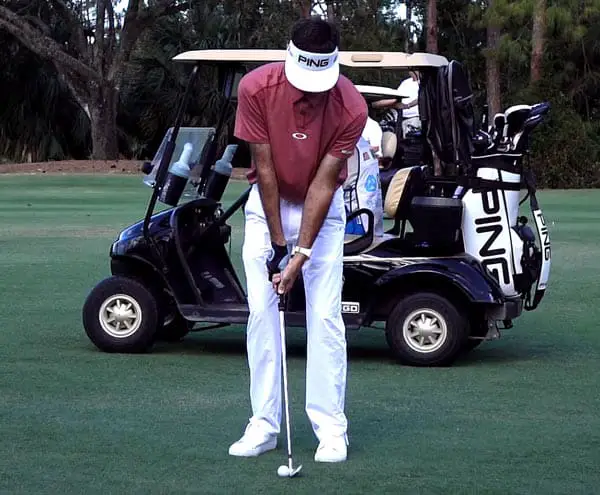
On a full pitch shot most pros use a slightly wider stance. It’s important to get the comprimise right between balance and rotation.
As a rule, it makes sense to have a slightly wider stance for longer clubs and swings. A longer swing demands more balance, so it will likely benefit from a wider stance.
But contrary to classic golf coaching, there probably isn’t a one size fits all approach. The classic progressive stance width is where the stance gets wider with each club and the ball position always remains inside the left heel.
But there’s no reason why you can’t use the same stance for all full swings if that’s what works. You can still change the ball position, even when your stance width stays the same.
You may find that using the same stance width for all full shots, all the way from 9 iron to driver, works best for you.
From looking at many of the modern pro’s swings, it seems clear that rotation and balance are two of the main keys golf swing. All the best players exhibit excellent rotation and balance. Many of the best players in the world use a wide stance and many use a narrow stance.
I think it is important to understand your own body and swing. Experiment with different stance widths and find out which one allows your body to move as well as possible.
In general, I think a more narrow stance offers the most benefits to the average golfer. Unless you are extremely flexibile, I think a narrow stance has the potential to benefit your rotation and weight transfer.
However, if you are someone that struggles with balance, you may find that a wider stance offers the most benefits.
It is worth noting that changing stance width is unlikely to massively improve your game on it’s own. If you are struggling with your swing it may be worth seeing a professional to help get you back on track.
Good luck everyone!

I’m Tom Rothwell and I’m a 3 handicaper that's obsessed with golf. You can often find me hitting balls on a driving range somewhere!
I'm on a journey to learn as much as possible about the great game. I've made Clean Strike Golf to share everything I discover along the way.